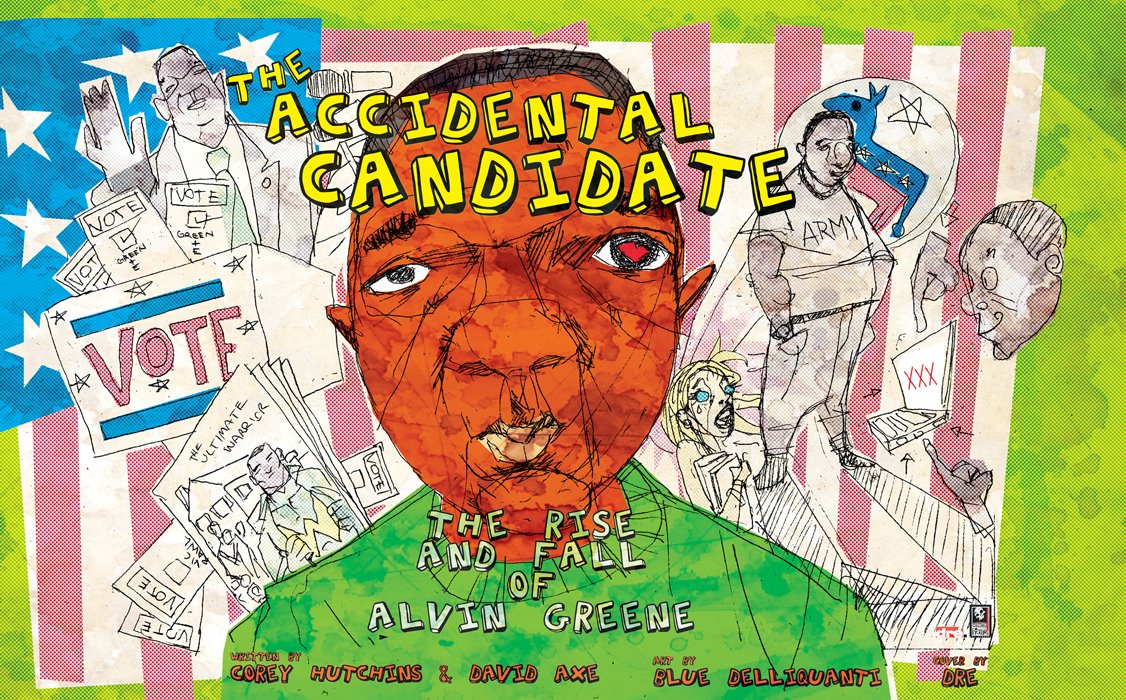Before I begin, I should admit to no real expertise with graphic novels. I have read only a handful before tackling The Accidental Candidate, the new book from Free Times reporter Corey Hutchins and freelance war correspondent and graphic novelist David Axe, with art by Blue Delliquanti and cover art Dre Lopez. However, each time I return to the medium, I am amazed by its power to tell a story in a way fundamentally different, but equally as compelling, as a traditional novel. The interaction between word and image and the momentum and movement that a narrative gains from the frame structure has its own beauty, and one should read a graphic novel or two for that experience if nothing else.
But enough about the medium — let’s talk about this particular book, which is not technically a “novel,” but a graphic non-fiction work; an emerging genre in which co-writer David Axe is a leader. The book chronicles, as the subtitle says, “The Rise and Fall of Alvin Greene,” South Carolina’s Democratic candidate for U.S. Senate in 2010.
If you’ve already forgotten this bizarre, and embarrassing, political spectacle — the kind of thing that can only happen in South Carolina — here’s the quick and dirty summary. Knowing that unseating Tea Party kingmaker Jim DeMint from his Senate seat was likely going to a be a Sisyphean task, nobody really geared up to take on the charge other than one former State House rep — who did only minimal campaigning before the primary — and Alvin Greene, a 32-year-old unemployed Army vet of whom nobody had ever heard, and who didn’t bother to campaign at all. But something strange, improbable, and a little suspicious happened — Greene won the primary in a landslide. Suddenly Greene became a huge story, as countless media outlets ran interviews of the socially awkward man, who lived with his father in Manning, SC, and who seemed to have painfully little political acumen, if indeed he had any at all.
The depiction of Greene by both the writers and Delliquanti seems to be deliberately unadorned, conveying not only the uncertain sense that Greene might not be “all there,” but also that he lives his life largely in his head as a misunderstood loner whose poor communication skills make him come across as less intelligent than he actually is. Hutchins and Axe don’t shy away from some of the more off-the-wall ideas that Greene came up with during the race — his suggestion that action figures of himself be made and sold to jump-start the economy and his claim that DeMint single-handedly started the recession, for example — but they avoid making those moments merely punch lines. Greene’s opponent in the primary, Vic Rawl, also comes off pretty well as an embattled defender of election fairness and democratic responsibility. It is primarily party figures on both sides who come off badly, as the writers read the Tea Party riot act and come down on the bumbling ineffectiveness of leadership in South Carolina’s Democratic Party.
As compelling as the basic story is here, though, it’s a little too straightforward and limited to carry the book by itself, so the writers use the story as a jumping off point to illustrate some troubling truths about our political discourse. Hutchins himself becomes one of the central characters in the book, as he recounts not only Greene’s story, but also his own role in the debacle. An astute reporter with a knack for long-form intensive journalism, Hutchins was the first and only reporter to cover Greene before the election, and also had the benefit of conducting some of the most in-depth interviews the candidate was willing to give. While his winning portrayal of himself might come off as self-serving to some, it also seems rightly earned, given his extensive coverage of the events in Columbia’s Free Times.
Hutchins and Axe’s depiction of Hutchins’ own efforts point to a glaring failure, in most traditional media outlets, when it comes to covering politics, as many of the biggest and most important stories go unreported while exhaustive attention is given to the horse race of polling and acquiring the cheap sound bite. Hutchins and Axe draw connections from Greene’s story to a variety of these issues, including the controversy over faulty voting machines (South Carolina bought their current batch from Mississippi, after the latter decided they weren’t reliable enough); the known shady practice by Republican operatives of planting poor black candidates in races in the South; the rise of the Tea Party; and, DeMint’s connections with the cultish fundamentalist group in DC known as The Fellowship.
In doing this, the team’s work fits into the emerging trend of non-traditional reporting techniques made both possible and necessary due to the rise of the Internet and 24-hour cable news. While most of the story comes directly from Hutchins’ own reporting on Greene, there is also a deft use of quotes from other journalists and national political figures that lends the book a weighty sense of argument.
— Kyle Petersen
(In addition to being the music editor for Jasper Magazine, Kyle Petersen holds a master’s degree in English from USC and is currently pursuing a PhD in American Literature. He is also a former employee of the SC Democratic Party Headquarters.)







.jpg)
Pingback: War Is Boring » Jasper on THE ACCIDENTAL CANDIDATE
Pingback: The Accidental Candidate | Jasper Reviews THE ACCIDENTAL CANDIDATE
Amazing how the art circle of Columbia sucks up to its regulars. Corey is an incredibly talented reporter, but David Axe is a pretty bad writer. Would it were that people would stop giving him attention.